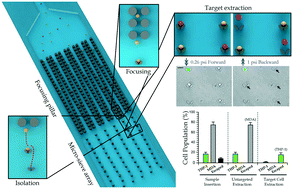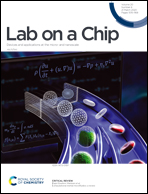Antibody-coated microstructures for selective isolation of immune cells in blood†
Abstract
Cell isolation from blood is an important process for diagnosing immune diseases. There are still demands for a user-friendly approach to achieve high cell extraction efficiency and purity of a target immune cell subtype for more promising diagnosis and monitoring. For selective immune cell isolation, we developed a microstructured device, which consists of antibody-coated micropillars and micro-sieve arrays, for isolating a target immune cell subtype from bovine blood samples. The focusing micropillars can guide immune cells flowing to the subsequent micro-sieves based on deterministic lateral shifts of the cells. The arrangement of these microstructures is characterized and configured for the maximal cell capture rate. Surface modification with a selected antibody offers selective cell capture in the micro-sieves based on the antigen–antibody reaction. We prepare a cell mixture of human CD14-expressing leukemia cells (THP-1) and epithelial cells (MDA-MB-231) in diluted blood to characterize the cell isolation operation, with a selective cell isolation yield of >80%, cell purity of ∼100% and cell viability of >93%. Together, this microstructured device strategy can achieve high-yield selective isolation of immune cells from blood samples and support downstream genetic and biochemical cell analyses, contributing to the medical diagnosis of a broad range of immune diseases.



 Please wait while we load your content...
Please wait while we load your content...